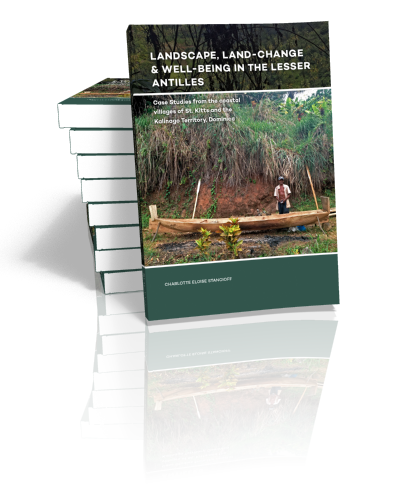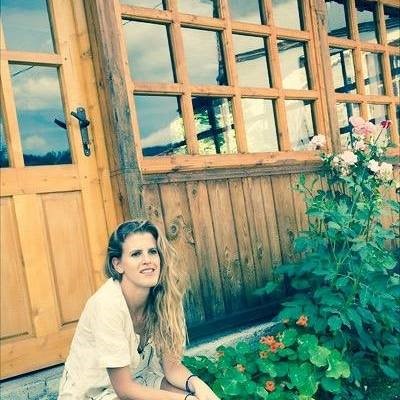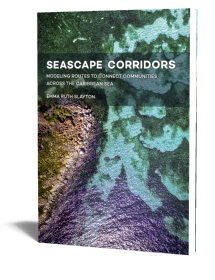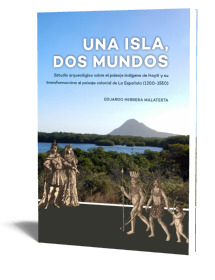Landscape, Land-Change & Well-Being in the Lesser Antilles
Case Studies from the coastal villages of St. Kitts and the Kalinago Territory, Dominica
Charlotte Eloise Stancioff | 2018

Landscape, Land-Change & Well-Being in the Lesser Antilles
Case Studies from the coastal villages of St. Kitts and the Kalinago Territory, Dominica
Charlotte Eloise Stancioff | 2018
Paperback ISBN: 9789088905865 | Hardback ISBN: 9789088905872 | Imprint: Sidestone Press Dissertations | Format: 182x257mm | 302 pp. | NEXUS 1492 | Language: English | 81 illus. (fc) | Keywords: land change, ecosystem services, community wellbeing, agriculture, rural landscapes, Caribbean archaeology | download cover
Read online or downloaded 1072 times
-
Digital & Online access
This is a full Open Access publication, click below to buy in print, browse, or download for free.
-
Buy via Sidestone (EU & UK)
-
Buy via our Distributors (WORLD)
For non-EU or UK destinations you can buy our books via our international distributors. Although prices may vary this will ensure speedy delivery and reduction in shipping costs or import tax. But you can also order with us directly via the module above.
UK international distributor
USA international distributor
-
Bookinfo
Paperback ISBN: 9789088905865 | Hardback ISBN: 9789088905872 | Imprint: Sidestone Press Dissertations | Format: 182x257mm | 302 pp. | NEXUS 1492 | Language: English | 81 illus. (fc) | Keywords: land change, ecosystem services, community wellbeing, agriculture, rural landscapes, Caribbean archaeology | download cover
Read online or downloaded 1072 times

We will plant a tree for each order containing a paperback or hardback book via OneTreePlanted.org.
In the Caribbean region, landscape change is part of the region’s history. The Caribbean exemplifies man-made changes to landscape, beginning with Amerindians, continuing to the importation of exotic species through the colony area, extreme land degradation caused by sugar plantation, forced settlement of millions of enslaved Africans, diverse populations of indentured laborers, and continued mixing of cultures from globalized interactions today, such as tourism. This has led to not only intense environmental degradation and introduction of new species, but the fostering of diverse cultures and communities – creating today’s melting pot of environment and community.
Today, the small islands of the Caribbean are often described as vulnerable: with limited resources, growing populations and a dependence on unsustainable economic markets. This perspective often overlooks the adaptability or resilience of these island communities.
However, with climate change and intensifying economic connection, landscape change will only increase, bringing not only changes to the ecology but to the customary practices and traditions that play an integral part in the rural community. How do we address these landscape modifications to build more sustainable and equitable land management techniques?
This research investigates the changing landscape and land use in two case studies of the coastal villages of St. Kitts and the Kalinago Territory of Dominica. By integrating human and ecological aspects of agrarian landscapes, this research analyzes how land degradation or land change impacts cultural ecosystem services, that ultimately disrupts community wellbeing. First, as a primary goal, the research focus is established together with local communities or stakeholders, identifying both direct and indirect causes of landscape change. Second, by using a variety of qualitative and quantitative methods, but grounded in local participation, the research indicates that landscape change never happens in a vacuum but rather, it is always a part of a larger socio-political context and historical background that must be considered. In both case studies, there remains emphasis on the tangible, as results not only lead to new directions in landscape research but also deliverables used by community stakeholders for continued land sustainability. By investigating the synergies of nature and community within landscape change, this research proposes that local communities assert their own agency. This moves away from how local communities fit into global phenomena of land change, to how communities can assert their diversity within a global process.
Also see the other publications from the NEXUS 1492 Research Project
List of Figures
List of Tables
Acknowledgments
Preface
1. Introduction
1.1 Rurality as a lens to global land change
1.2 The imagined islands: the historic context of the Caribbean
1.3 Research questions and overview
1.4 Scope and rationale of the research
2. Theoretical framework
2.1 Introduction
2.2 Current landscape theory: research trends and directions
2.3 Socio-ecological systems: the origins and definitions of terms
2.4 Landscape, community and well-being
3. Methodology
Part I. Macro factors of a system: society and ecology
3.1 Overall methods and approach
3.2 Research principles: the socio-ecological indicators
3.3 Analysis of the land-use and the land-change
Part II. Micro factors of the local landscape context
3.4 The coastal villages of St. Kitts: the study area and background
3.5 The Kalinago Territory, Dominica: study area and background
3.6. Final thoughts on the challenges and partnerships
4. The coastal villages of St. Kitts: the bitterness of sugar
Part I. A recent history of the Kittitian landscape
4.1 St. Kitts under British colonization
Part II. Landscape: use, modification and value
4.2 Multiple use of lands: analyzing the land-cover change
4.3 Resource conservation: the impacts of coastal erosion, rising sea levels and beach access restrictions
4.4 Shifting community: socio-cultural aspects of landscape change
Part III: The significance of fallow land: case study observations
5. The Kalinago Territory: land for survival, land as a burden
Part I. A recent history of the Kalinago landscape
5.1 The Kalinago Territory and its historical background
Part II. Landscape: use, modification and value
5.2 Multiple uses of the land: an analysis of the land-cover changes
5.3 Resource Conservation: Water Resources
5.4 Shifting community: the socio-cultural aspects of landscape change
Part III: The Kalinago Territory at a crossroads
6. Discussion and Conclusions
6.1 Discussion on the case study findings
6.2 Innovation and implications of the methodology
6.3 Final conclusions
Appendices

Dr. Charlotte Eloise Stancioff
Charlotte Eloise Stancioff is a Bulgarian-American GIS and Ecosystem services specialist. Born in Washington, DC but residing in the Netherlands, She holds a a BA in International Relations and Geography at the University of Chapel Hill in North Carolina and a MSc in Geoinformatics at the University of Toulouse-Jean Jaurès/ École Nationale Supérieure Agronomique in Toulouse, France.
Abstract:
In the Caribbean region, landscape change is part of the region’s history. The Caribbean exemplifies man-made changes to landscape, beginning with Amerindians, continuing to the importation of exotic species through the colony area, extreme land degradation caused by sugar plantation, forced settlement of millions of enslaved Africans, diverse populations of indentured laborers, and continued mixing of cultures from globalized interactions today, such as tourism. This has led to not only intense environmental degradation and introduction of new species, but the fostering of diverse cultures and communities – creating today’s melting pot of environment and community.
Today, the small islands of the Caribbean are often described as vulnerable: with limited resources, growing populations and a dependence on unsustainable economic markets. This perspective often overlooks the adaptability or resilience of these island communities.
However, with climate change and intensifying economic connection, landscape change will only increase, bringing not only changes to the ecology but to the customary practices and traditions that play an integral part in the rural community. How do we address these landscape modifications to build more sustainable and equitable land management techniques?
This research investigates the changing landscape and land use in two case studies of the coastal villages of St. Kitts and the Kalinago Territory of Dominica. By integrating human and ecological aspects of agrarian landscapes, this research analyzes how land degradation or land change impacts cultural ecosystem services, that ultimately disrupts community wellbeing. First, as a primary goal, the research focus is established together with local communities or stakeholders, identifying both direct and indirect causes of landscape change. Second, by using a variety of qualitative and quantitative methods, but grounded in local participation, the research indicates that landscape change never happens in a vacuum but rather, it is always a part of a larger socio-political context and historical background that must be considered. In both case studies, there remains emphasis on the tangible, as results not only lead to new directions in landscape research but also deliverables used by community stakeholders for continued land sustainability. By investigating the synergies of nature and community within landscape change, this research proposes that local communities assert their own agency. This moves away from how local communities fit into global phenomena of land change, to how communities can assert their diversity within a global process.
Also see the other publications from the NEXUS 1492 Research Project
Contents
List of Figures
List of Tables
Acknowledgments
Preface
1. Introduction
1.1 Rurality as a lens to global land change
1.2 The imagined islands: the historic context of the Caribbean
1.3 Research questions and overview
1.4 Scope and rationale of the research
2. Theoretical framework
2.1 Introduction
2.2 Current landscape theory: research trends and directions
2.3 Socio-ecological systems: the origins and definitions of terms
2.4 Landscape, community and well-being
3. Methodology
Part I. Macro factors of a system: society and ecology
3.1 Overall methods and approach
3.2 Research principles: the socio-ecological indicators
3.3 Analysis of the land-use and the land-change
Part II. Micro factors of the local landscape context
3.4 The coastal villages of St. Kitts: the study area and background
3.5 The Kalinago Territory, Dominica: study area and background
3.6. Final thoughts on the challenges and partnerships
4. The coastal villages of St. Kitts: the bitterness of sugar
Part I. A recent history of the Kittitian landscape
4.1 St. Kitts under British colonization
Part II. Landscape: use, modification and value
4.2 Multiple use of lands: analyzing the land-cover change
4.3 Resource conservation: the impacts of coastal erosion, rising sea levels and beach access restrictions
4.4 Shifting community: socio-cultural aspects of landscape change
Part III: The significance of fallow land: case study observations
5. The Kalinago Territory: land for survival, land as a burden
Part I. A recent history of the Kalinago landscape
5.1 The Kalinago Territory and its historical background
Part II. Landscape: use, modification and value
5.2 Multiple uses of the land: an analysis of the land-cover changes
5.3 Resource Conservation: Water Resources
5.4 Shifting community: the socio-cultural aspects of landscape change
Part III: The Kalinago Territory at a crossroads
6. Discussion and Conclusions
6.1 Discussion on the case study findings
6.2 Innovation and implications of the methodology
6.3 Final conclusions
Appendices

Dr. Charlotte Eloise Stancioff
Charlotte Eloise Stancioff is a Bulgarian-American GIS and Ecosystem services specialist. Born in Washington, DC but residing in the Netherlands, She holds a a BA in International Relations and Geography at the University of Chapel Hill in North Carolina and a MSc in Geoinformatics at the University of Toulouse-Jean Jaurès/ École Nationale Supérieure Agronomique in Toulouse, France.
-
Digital & Online access
This is a full Open Access publication, click below to buy in print, browse, or download for free.
-
Buy via Sidestone (EU & UK)
-
Buy via our Distributors (WORLD)
For non-EU or UK destinations you can buy our books via our international distributors. Although prices may vary this will ensure speedy delivery and reduction in shipping costs or import tax. But you can also order with us directly via the module above.
UK international distributor
USA international distributor
- Browse all books by subject
-
Search all books

We will plant a tree for each order containing a paperback or hardback book via OneTreePlanted.org.
You might also like:
© 2025 Sidestone Press KvK nr. 28114891 Privacy policy Sidestone Newsletter Terms and Conditions (Dutch)







